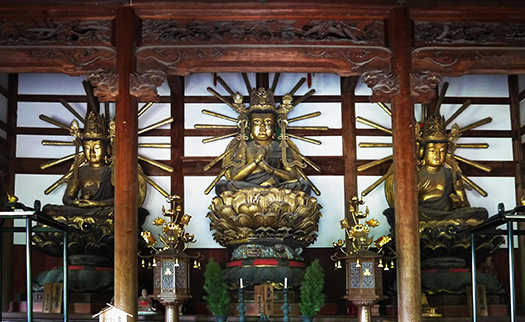


仏教建築を探っていくとやはり本尊という存在は中核的な位置を占める。
建築と相互に関係しながらその建築の基本趣旨を語るもの。
基本的な宗教的意味を踏まえつつも、衆生として感受可能な表現物、芸術。
宗教側からすれば「広布」のための最重要メッセージだと思う。
建築的にはこの仏像がどう見えるか、どう安置されるかが中核的意図になる。
日本の寺院の最初期の587年着手の飛鳥寺での止利仏師はどうも専門家ではなく
建築関連、それも鞍製造と関わっての金属加工の専門家集団の棟梁という存在から
江戸期の円空さんのように僧であり芸術者という存在までがあるけれど、
徐々に職業的な専門分野として成立してきたものなのでしょう。
寺院という独立的な経済体が日本社会で成立しそのなかで職掌が分化していった。
学僧と行人というような宗教関係者の職掌分化がこの根来寺の時代には顕著。
行人というのは、寄進を受けた経済組織としての農地、
たとえば高野山は全国各地に17万石分の寄進された領地を保有していた。
そうした寺院の経済構造を管理し運営していく組織人だったのでしょう。
僧兵などはその最たるものですが、仏師というのも類した存在のように思える。
学僧のトップの僧侶からある宗教的概念・コンセプトの開示があって
その開示の内容に即して仏師は想像力豊かに創作していったものでしょう。
もちろん典拠となる仏教経典にはそうした「イメージ」の基礎が書かれていた。
止利仏師とか円空さんには「作風」が強く感じられて
一個の芸術作品という側面が強く意識される。
仏教概念表現の内容部分には衆生はあまり反応のしようがないと思う。
そうではなく表現としての作家個性、人間性の方がはるかに「伝わる」。
先日の東京国立博物館での天台の仏像展では前者的な部分にスポットが当てられ
観覧する衆生からすると感情移入しにくく印象が薄かった。
この仏像は宗教的意味合いがどうこう、みたいな講釈は全然響いてこない。
この根来寺中核施設・伝法堂の本尊は1387〜1405年頃に制作された。
587年の飛鳥寺・止利仏師からははるかに800年の時間経過。
木造大日如来坐像・金剛薩埵坐像・尊勝仏頂坐像 – 大伝法堂に三尊として、
中央に大日如来、左方(向かって右)に金剛薩埵(こんごうさった)右方(向かって左)に
尊勝仏頂を安置する。像高は順に350センチ、343センチ、335センチ。
建物は江戸時代後期の再建だがこの三尊像は秀吉の焼き討ちをまぬがれたもので、
大日如来像及び金剛薩埵像内の墨書から1387年から1405年制作と判明。
仏像彫刻衰退期の室町時代における佳作と評価されている。
大日如来〜真言密教教主で一切の仏菩薩の本地、一切の徳の総摂の仏。
金剛薩埵〜大日如来と衆生の菩提心をつなぐ役割をもつ一尊。
尊勝仏頂〜一切の害障を除く功徳を象徴。仏頂最勝なので尊勝の名。
このような三尊の組み合わせは珍しく中でも尊勝仏頂は彫像としては稀有の遺品。
この三尊の組み合わせは、根来寺開基の覚鑁が高野山に建立した大伝法院に
すでにあったことが知られ、独自の教義解釈による組み合わせという。
室町中期ということで作家名は不祥とされている。
なんですが、大日如来さんの表情はなにかかわいらしい印象を与える。
巨大な仏像だけれど威嚇的とは不思議と感じない。そのあたりがコンセプトか?
光背の表現もかなり特異的ではないだろうか。
平和的統一感よりも教化への強い意志力を表現した、みたいな。
English version⬇
[Three main idols of the Buddhist temple created around 1400 Kishu Negoroji-6]
When exploring Buddhist architecture, the existence of the principal image occupies a central position.
It talks about the basic purpose of architecture while interacting with it.
Expressions and art that can be felt as sentient beings while keeping the basic religious meaning.
From the religious point of view, I think it is the most important message for “wide cloth”.
Architecturally, the core intention is how this Buddha image looks and how it is enshrined.
Tori Busshi at Asuka-dera, the earliest Japanese temple to start in 587, is not an expert.
Building-related, because of the existence of a group of metalworking specialists involved in saddle manufacturing
There are even monks and artists like Enku in the Edo period,
Perhaps it has gradually been established as a professional field.
An independent economic body called a temple was established in Japanese society, and the duties were divided within it.
The division of duties between religious people such as scholars and gyōnin is remarkable in this Negoroji era.
A farmer is a farmland as an economic organization that has received donations.
For example, Koyasan owned 170,000 stones of donated territories all over the country.
Perhaps he was an organizer who managed and operated the economic structure of such temples.
The monks are the best, but the Buddhist priest seems to be a similar existence.
There is a disclosure of a religious concept / concept from the top monks of the scholars
The Buddhist priest would have created with a lot of imagination according to the contents of the disclosure.
Of course, the basis of such an “image” was written in the Buddhist scriptures that serve as the authority.
Tori Busshi and Enku-san strongly felt the “style”.
The aspect of one work of art is strongly conscious.
I don’t think sentient beings can react much to the content of Buddhist conceptual expression.
Instead, the artist’s individuality and humanity as expressions are far more “transmitted”.
At the Buddha statue exhibition at Tendai at the Tokyo National Museum the other day, the former part was spotlighted.
From the sentient beings who watched it, it was difficult to embrace emotions and the impression was weak.
This Buddha image doesn’t sound like a religious story at all.
The principal image of this Negoro-ji core facility, Denpo-do, was created around 1387 to 1405.
It has been 800 years since Asuka-dera and Tori Busshi in 587.
Wooden Dainichi Nyorai sitting statue, Vajrasattva sitting statue, Usnisavijaya sitting statue-As the head and shoulders of the Daidenhodo
Dainichi Nyorai in the center, to the left (to the right), to the right (to the left)
Enshrine the Usnisavijaya. The image heights are 350 cm, 343 cm, and 335 cm, respectively.
The building was rebuilt in the latter half of the Edo period, but this Sanson statue survived Hideyoshi’s burning.
It turned out that it was produced from 1387 to 1405 from the ink book in the statue of Dainichi Nyorai and the statue of Vajrasattva.
It is evaluated as an honorable mention in the Muromachi period during the decline of Buddhist sculpture.
Dainichi Nyorai-The Buddhist priest of Shingon Esoteric Buddhism, the home of all Buddhist Bodhisattvas, and the total virtues of all virtues.
Vajrasattva-Ichison who has the role of connecting Dainichi Nyorai and the bodhicitta of sentient beings.
Usnisavijaya-Symbolizes the highest merit of the Buddha without any harm. It is the name of the honorable victory because it is the most victorious of the Buddha’s summit.
Such a combination of three sacred statues is rare, and the Usnisavijaya is a rare relic as a statue.
This combination of the three gods is in the Daidenhoin, which was built on Mt. Koya by Kakuban, the founder of Negoro Temple.
It is known that it already existed, and it is called a combination based on its own doctrinal interpretation.
The writer’s name is said to be unscrupulous because it is in the middle of the Muromachi period.
However, Vairocana’s facial expression gives a pretty impression.
It’s a huge Buddha statue, but it doesn’t seem strange to be menacing. Is that the concept?
Isn’t the expression of the halo quite peculiar?
It seems to express a strong will to indoctrination rather than a sense of peaceful unity.
Posted on 11月 19th, 2021 by 三木 奎吾
Filed under: 住宅マーケティング, 日本社会・文化研究, 歴史探訪







コメントを投稿
「※誹謗中傷や、悪意のある書き込み、営利目的などのコメントを防ぐために、投稿された全てのコメントは一時的に保留されますのでご了承ください。」
You must be logged in to post a comment.